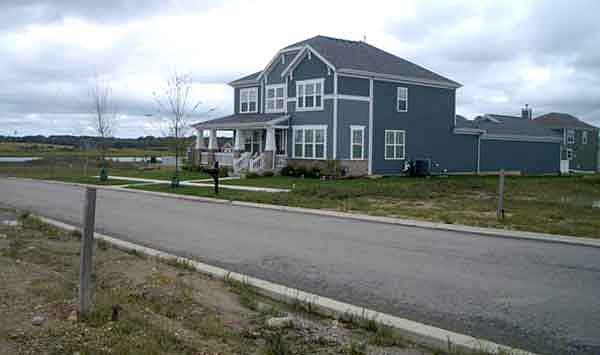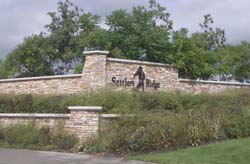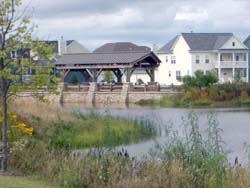
Work stopped at Settlers Ridge when only 110 of the proposed 2,470 homes had been built. |
|
|
|
|
Back in the summer of 2006, a subdivision called Settlers Ridge was the hottest thing in Sugar Grove, a small town west of Aurora in Kane County. The homebuilder Kimball Hill had begun work on what was intended to become a model of contemporary suburban growth: 2,470 traditionally styled homes—many of them with their garages tucked out back on alleys—would cluster together on 780 acres and look out over another 520 acres of open space that encompassed neighborhood play lots, restored prairies, large ponds, and stone footbridges.
Settlers Ridge would account for more than one-third of the almost 7,000 house lots that were going to be developed in Sugar Grove, a housing boom that would triple the size of the town in a decade. “We accepted growth; we realized you can’t stop it from coming,” says Sean Michels, who was then and still is Sugar Grove’s village president. “Settlers Ridge was going to be a major part of Sugar Grove’s growth.”
But by the time the first buyers were moving into their new Settlers Ridge homes in late 2006, things had started to change. The real-estate market had begun slowing down to such an extent that developers called off construction on at least one other subdivision in Sugar Grove. In 2007, several dozen more homeowners moved in to Settlers Ridge, but the market continued to sour. By spring 2008, Kimball Hill was headed into bankruptcy. Work stopped at Settlers Ridge, with 110 homes completed, and in June Kimball Hill put the rest of the property up for sale.
The Settlers Ridge collapse impacted the entire village. In the year ending June 30, 2007 (according to information from Midwest Real Estate Data), houses that were sold in Sugar Grove had an average market time of 15 days; in the year ending June 30, 2008, the average had shot up to 213 days.
That latter figure appears on Chicago’s annual real-estate chart in its October 2008 issue. On the chart, which surveys local residential real-estate sales in the 12-month period from July 1, 2007, to June 30, 2008, there is a column tracking a suburb or neighborhood’s average market time. But there is no column tracking the change in market time from one year to the next, a statistic I want to look at here. Keep in mind that some suburbs and neighborhoods on the chart may have a longer average market time. What I’m looking at here are those towns and neighborhoods with the greatest increase in market time since last year’s chart.
Sugar Grove is by far the suburb hardest hit by the slowdown, with houses taking 13 times as long to sell this year than they did the year before. Following Sugar Grove are six suburbs and neighborhoods where houses took at least twice as long to sell than they had the year before. (For our purposes here, suburbs had to have at least 25 sales of single-family homes during the year; city neighborhoods, which are smaller, had to have at least 20.)
| Suburb | 2007 market time | 2008 market time | Percentage Increase |
| Summit | 88 days | 230 days | 160% |
| Elburn | 102 days | 258 days | 153% |
| Wadsworth | 111 days | 253 days | 128 % |
| Bensenville | 89 days | 186 days | 109% |
| Neighborhood | 2007 market time | 2008 market time | Percentage Increase |
| Burnside | 67 days | 149 days | 122% |
| Uptown | 100 days | 203 days | 103% |
These are the places with the steepest slowdowns, but in all, 91 percent of the towns and suburbs on our chart saw market slowdowns of some kind.
But nothing on the chart compares to what happened in Sugar Grove.
Among the houses at Settlers Ridge that sold during the past year, one took 205 days to sell, another took 309, and a third lingered on the market for 448 days. There were other slow-to-sell properties in the town, but Settlers Ridge clearly had the biggest impact. “I’d put most of the blame on Settlers Ridge,” says Lisa Sloan, a broker whose company, Sloan Realty, has sold several houses in the subdivision. Sloan acknowledges liking the development’s houses and layout—and its good connections to shopping in Aurora and downtown Chicago by expressway—but she still finds problems with the original concept. “It was too much,” she says. “Sugar Grove allowed too much expansion.” (Sloan also quibbles with the way Kimball Hill marketed the subdivision.)
In retrospect, Michels, the village president, believes Settlers Ridge came on line too late. “We had a number of [smaller] subdivisions finish up in 2004 and 2005,” he says, “and then some big ones came in for approval in [late] 2005. But the slowdown started in 2006, before they could get going.”
Settlers Ridge is certainly not the only subdivision halted by the severe downturn in the housing market, and Kimball Hill is only one among several homebuilders that faltered. But market time for Sugar Grove houses may already be improving: according to Michels, who is a builder and whose mother is a local real-estate agent, new houses in town have been moving fast so far this summer and fall.
Most construction is at a halt in Settlers Ridge—there are a few houses underway by other builders that bought lots from Kimball Hill—so the subdivision won’t exert much influence over the local real-estate market in the next year. But at some point, if another developer takes over the plan—and if a recovering real-estate market looks happily on exurban subdivisions—Settlers Ridge could become a powerhouse again. For now, though, its isolated houses and its paved streets petering off into weedy mounds of dirt remain hallmarks of a place that might have been.
 Back in the summer of 2006, a subdivision called Settlers Ridge was the hottest thing in Sugar Grove, a small town west of Aurora in Kane County. The homebuilder Kimball Hill had begun work on what was intended to become a model of..." />
Back in the summer of 2006, a subdivision called Settlers Ridge was the hottest thing in Sugar Grove, a small town west of Aurora in Kane County. The homebuilder Kimball Hill had begun work on what was intended to become a model of..." />




 Settlers Ridge would have accounted for one-third of the nearly 7,000 new homes to be built in Sugar Grove.
Settlers Ridge would have accounted for one-third of the nearly 7,000 new homes to be built in Sugar Grove.